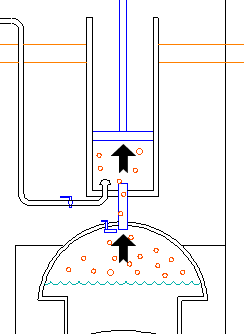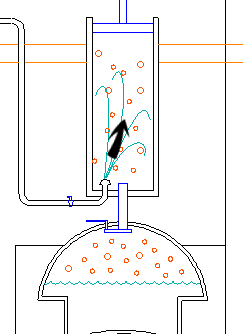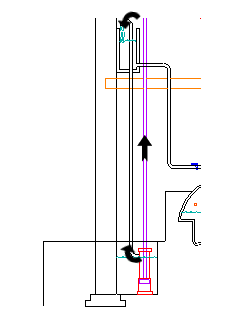Newcomen Atmospheric Engine
This magnificent engine was patented in 1705 by Thomas Newcomen, and is generally regarded as the first “modern” steam engine. Unlike later steam engines, the Newcomen works on the atmospheric principle.
The Newcomen was first used to pump water from mines in England. The pump rod on the left is coupled to the driving piston by a large rocking beam.

Intake
Water is boiled continuously to produce steam. During the piston’s upward stroke, this low pressure steam (about 5 p.s.i.) is admitted to the cylinder. The pressure is insufficient to lift the piston on its own—the weight of the pump rod does most of the work.

Water injection
At the top of the stroke, the steam valve is closed and a water jet is briefly turned on, cooling the steam in the cylinder.

Power
The cool steam contracts, sucking the piston downward. In other words, the higher atmospheric pressure drives the piston downward, hence the name atmospheric engine. At the end of the stroke, the cooling water is drained from the cylinder by an extra passage not illustrated here.

Auxiliary pump
During the upward stroke, an auxiliary pump fills the cooling water reservoir.
Newcomen engines were successful in part because they were very safe to operate. Since the steam was under such low pressure, there was no risk of a dangerous boiler explosion.
Note on the valve mechanism
The earliest Newcomen engines featured manually operated valves (as illustrated here). An operator stood on a platform near the cylinder base and threw the valve levers on each stroke.
Popular legend has it that the boys in charge of this tedious task invented the automatic valve by jury-rigging ropes and levers for the purpose.
The book Thomas Newcomen, The Prehistory of the Steam Engine convincingly dispels this notion and gives details of the automatic valves developed by Newcomen and his associate John Calley. For more on the Newcomen engine, I highly recommend this book. I hope to illustrate the automatic valves someday.

 Follow
Follow Befriend
Befriend Subscribe
Subscribe